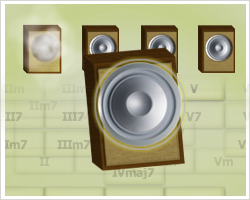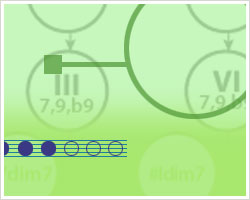A chord progression is a sequence of chords. Chord progressions are often used to harmonize melodies. The chords that appear in a typical progression are closely associated with the key of a song. For example, take the key of C Major and its associated scale:
| C Major: | 1 | 2 | 3 | 4 | 5 | 6 | 7 |
| C | D | E | F | G | A | B |

| I | IIm | IIIm | IV | V | VIm | VIIdim |
In the key of C Major, these chords are the ones most likely to appear in a chord progression. The one exception is the VII diminished chord, which tends to show up more often in jazz and classical than in pop music. Notice that for chords we use roman numerals to represent the chord numbers within a key, rather than the arabic numerals which are used for numbering the scale steps. In any key, the tonic tone and the tonic chord carry the most weight.
All the other chords and tones tend to gravitate back toward the tonic tone and the "I" chord. If you think of harmony as a solar system, the I chord is the sun - the center of the universe. In a major key, there are three "primary" chords, which are the most important chords in that key and tend to show up more often than other chords. These primary chords are the I, IV and V. The vast majority of folk, gospel, blues and good bit of rock music are based around these three chords.
All tonal music makes heavy use of primary chords, so learning to recognize the I, IV and V in any key is a crucial part of your ear training. Chords tend to progress from one to another in very typical ways. By knowing the common patterns, you gain valuable clues that can save time when you're trying to figure out the chords to a song by ear. One very general rule is that chords within a key very often move in fifths:
Whenever you have identified one of the above chords in a progression and are looking for the next chord in the sequence, you can look at the chart above to find a very strong candidate! Certain sequences of chords tend to come up over and over again in popular music, so it is very helpful to be able to recognize these patterns.
By learning the patterns as numbers (in roman numeral format), you will be able to identify them in all keys. As an added benefit, knowing the important chords and patterns in all keys will also help you to better remember songs you've already learned. With enough training, you start to mentally group certain chords together, making it easier to remember them in the songs you already know.
Speaker Chords will help you recognize which chords are commonly found together in the same song. You will learn to identify chord patterns from a wide variety of styles and genres, and you will better understand the relationships between chords in the same key. By playing Speaker Chords regularly, you will soon be able to quickly name the chords from almost any song you hear.



